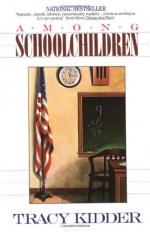|
This section contains 630 words (approx. 2 pages at 400 words per page) |

|
Among Schoolchildren Summary & Study Guide Description
Among Schoolchildren Summary & Study Guide includes comprehensive information and analysis to help you understand the book. This study guide contains the following sections:
This detailed literature summary also contains Topics for Discussion and a Free Quiz on Among Schoolchildren by Tracy Kidder.
Among School Children by Tracy Kidder is an account of Christine Zajac's fifth grade classroom at Kelly School in Holyoke Massachusetts. For an entire year, Kidder observed Chris' classroom. Through his observations, Kidder explains the trials and tribulations that Chris must go through as a teacher in a poor neighborhood in the United States. He uses Chris' anecdotes as a larger comment on the American school system as a whole.
The novel begins with Chris preparing her classroom for school. It is September and while Chris has enjoyed her Summer vacation, she is ready for a new batch of children. On the first day, the children assess Chris. She makes it clear that while she will treat them fairly and is sweet, she demands the best. If a student does not do her best, she will make them do it again. On the first day, one child catches her attention. Clarence is an adorable African American boy. Chris immediately realizes that he cannot keep still or concentrate in class. The first week starts and Clarence does no homework. Chris demands that he do so by keeping him after school and refusing him recess. Already, this is turning out to be a rough year.
Clarence is not Chris' only problem child. Robert likes to physically hurt himself for attention; Chris is afraid that Pedro is developmentally challenged; Jimmy falls asleep in class. Chris' class management skills are really getting a work out. Luckily, Chris also has Judith, an extremely smart Puerto Rican girl from the Flats. Judith is always looking to learn more. She offers Chris sanity amongst the madness in the classroom. To Ms. Hunt, Chris' student teacher, Chris is amazing at controlling the class. Whenever Pam attempts to teach, she looses control of the classroom. Kidder points out that teaching is a hard profession to train for. While teachers are expected to go to college and do student teaching to get ready for their own classrooms, sometimes it is not enough. Often, teachers are thrown into the fire without any preparation. Kidder insists that America should put more emphasis in training teachers, so that they are better equipped to handle children like Clarence and Robert.
As the year progresses, Chris' problem with Clarence escalates. He is causing physical harm to other children, disrupting the class, and causing Chris anxiety. Chris really tries her hardest to control Clarence, but her attempts fail. He is finally removed from her classroom by the school administration. Chris feels as though she has failed Clarence, but now that he is gone, she is able to concentrate on the rest of her class. Chris can now help Claude, who never really started learning. She has time to push him whereas with Clarence in the room, she had no time for anyone but Clarence.
Throughout the book, Kidder also tries to show the inequality of education and ethnicity in American schools. Chris is a teaching that expects the best out of her students, but many teachers are not like this. They give up on students before they can make a difference. If the teacher is not pushing the child and there is no support from a parent, children do not get motivated. This can often be linked to the social economic class of the child. Children from poorer backgrounds have younger parents who do not always take an interest in the children lives and educations. Therefore, education cannot equalize.
Finally, the year draws to a close. Chris is happy with the progress that many of her students made, but also upset that they have not changed more. She did everything she could in the time that was allotted. It is not that she did not try. She simply ran out of time.
Read more from the Study Guide
|
This section contains 630 words (approx. 2 pages at 400 words per page) |

|



